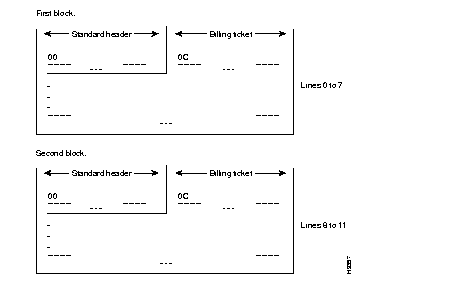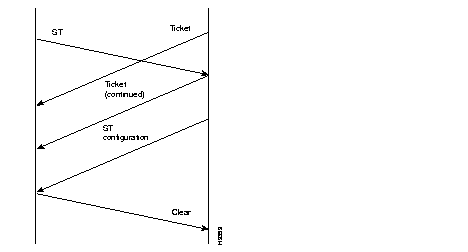|
|

This management function collects all billing data, for lines configured in billing mode, in the form of tickets.
A configuration parameter for each line determines if the line is in billing mode or not.
Two types of billing are possible:
| · Overall: | Billing data covering all lines, |
| · Detailed: | Billing data for each call, whether successful or otherwise (data used for accounting). |
An overall billing ticket is continuously updated until an issue request is received from an operator or control centre.
When this ticket is issued it becomes the "new overall billing ticket". A copy is conserved, to prevent the risk of a ticket being lost during the printing process. This copy then becomes the "old overall billing ticket".
The current billing print request erases the old billing ticket record and replaces it with the copy of the current billing print.
This ticket is contains the following parameters:
A detailed billing ticket is generated when the quantity of the switched data has reached a threshold, called the intermediate threshold. The intermediate threshold is a number of segments of 64 data bytes.
In case of a long-duration communication, an intermediate detailed billing ticket is generated each time the number of data segments exceeds the intermediate threshold.
The detailed tickets are stored in memory until a display/print request is received from an operator or control center.
The number of detailed billing tickets stored in memory is limited by the following thresholds:
For the FastPADmp, the thresholds are initialized with the following values:
| intermediate threshold: | 10.000 segments of 64 bytes |
| alarm threshold: | 20 |
| ticket threshold: | 100. |
Detailed billing tickets contain a cyclic counter, which indicates to the user whether any tickets have been lost.
Tickets could be lost when:
The data provided enables the calls to be charged, differentiating between data transmission directions:
Access code syntax is:
· IS No: | 07: | binary mode | |
| 08: | ASCII mode | ||
· PASSWORD: | Password exists if configured ("TX" by default) | ||
· ACO No: | The breakdown of the suffix is: | ||
| ACO non existent | Distribution of detailed billing tickets. | ||
| ACO = 1 | |||
| ACO = 2 | Distribution of current overall billing ticket. | ||
| ACO = 3 | Distribution of old overall billing ticket. | ||
| ACO = 4 | Distribution of old overall billing ticket and detailed billing tickets. | ||
A call is refused in the following cases:
An overall billing ticket comprises two blocks:
| · first block: | data for lines 0 to 7 |
| · second block: | data for lines 8 to 11. |
An overall taxation ticket consists of five blocks:
| · first block: | contains data for the lines 0 to 7 |
| · second block: | contains data for the lines 8 to 15 |
| · third block: | contains data for the lines 16 to 23 |
| · fourth block: | contains data for the lines 24 to 31 |
| · fifth block: | contains data for the lines 32 to 35. |
An overall billing ticket is made up of information blocks relating to lines 0 to 5.
All blocks contain the same standard header.

Data contained in a ticket is defined in Table 11-1.
| Byte Position (hexadecimal) | Contents |
| 00 to 0B | Standard header |
| 0C and 0D + (n1x8)
0E and 0F + (nx8) 10 to 13 + (nx8) 6C | Line number
Number of packets of calls on the line Number of segments of 64 bytes on the line Indicator of "billing ticket to follow" (0 = no, 1 = yes) |
Detailed billing ticket is shown below:

Data contained in a ticket is defined in Table 11-2.
| Byte Position (hexadecimal) | Contents |
|---|---|
| 00 to 0B | Standard header |
| 0C | Billing ticket to follow 0 : final ticket 1 : intermediate ticket |
| 0D | Call identifier/X.75 |
| 0E and 0F | Not significant |
| 10 | Reserved billing indicator on request Value of reserved billing, fast selection received in call or default value 0. |
| 11 to 13 | Duration of communication (in 1/10s) |
| 14 | Reason for end of communication* (for cause and diagnostics, see bytes 3E and 3F) |
| 15 | Not significant (TRANSPAC prefix) |
| 16 and 17 | Cyclic ticket number (0 to 65535) |
| 18 to 2B | TNIC list (10 DNICs max.); FF = not significant |
| 2C | Number of digits in the full calling address |
| 2D to 34 | Full calling address |
| 35 | Number of digits in full address of called subscriber |
| 36 to 3D | Full address of called subscriber; for one management function, the internal service number is given. |
| 3E | Reset cause (byte 14) |
| 3F | Reset diagnostic (byte 14) |
| TICKET ZONE CONTAINING DATA TRANSMITTED FROM CALLING TO CALLED SUBSCRIBER | |
| 40 | Module number that received the call |
| 41 | Line number that received the call |
| 42 | Requested throughput class (specified or default value) in call received, or transmission from calling to called subscriber. This field is completed only when the call confirmation is processed. |
| 43 | Throughput class obtained for communication and from calling to called subscriber. This field is only written when call confirmation is processed. |
| 44 and 45 | CNIC number (clearing network) |
| 46 to 4D | Reserved for future services |
| 4E | Total gain in volume (bytes), generated by the compression function and stated in tenths. |
| 4F | Total gain in billing (in segments), generated by the compression function and stated in tenths. |
| 50 and 51 | Counter of interrupt packets transmitted from the calling to the called subscriber |
| 52 and 53 | Counter of reset packets transmitted from the calling to the called subscriber |
| 54 to 57 | Counter of data segments (segment = 64 bytes) transmitted from calling to called subscriber |
| 58 to 5B | Counter of data packets transmitted from calling to called subscriber |
| 5C to 5F | Counter of data bytes transmitted from calling to called subscriber |
| TICKET ZONE CONTAINING DATA TRANSMITTED FROM CALLED TO CALLING SUBSCRIBER | |
| 60 | Module number that transmitted the call |
| 61 | Line number that transmitted the call. For the management functions, special numbers have been assigned: |
| E0: Traffic generator E5: Transfer | |
| E1: OEV E7: Configurator | |
| E2: Line observation E9: Telemaintenance | |
| E3: Statistics 70: IMM | |
| E4: Billing | |
| 62 | Similar to bytes 42 |
| 63 | Similar to bytes 43 |
| 64 to 6D | Not significant |
| 6E | Similar to byte 4E |
| 6F | Similar to byte 4F |
| 70 and 71 | Similar to bytes 50 and 51 |
| 72 and 73 | Similar to bytes 52 and 53 |
| 74 to 77 | Similar to bytes 54 to 57 |
| 78 to 7B | Similar to bytes 58 to 5B |
| 7C to 7F | Similar to bytes 5C to 5F |
bit 0: | at 1 if call successfully passed through equipment |
|---|---|
| bit 1: | at 1 if call confirmation successfully passed through equipment |
| bit 2: | at 1 if clear is due to equipment |
| bit 3: | at 1 if reason for release is at called end |
| bit 4: | at 1 if clear is due to subscriber (DTE) |
| bit 5: | at 1 if clear is due to procedure error |
| bit 6: | at 1 if clear is due to network incident. |
If the control center wishes to clear the virtual circuit without loss of tickets through the network, then the two ASCII characters "ST" must be transmitted to the charging function.
In this case, the billing function finishes the distribution of tickets in progress. At the end of the distribution it confirms the closure of the switched VC, by sending the following data packet:
Ticket distribution then stops and the control center can then close the virtual circuit with no risk of loss.

|
|